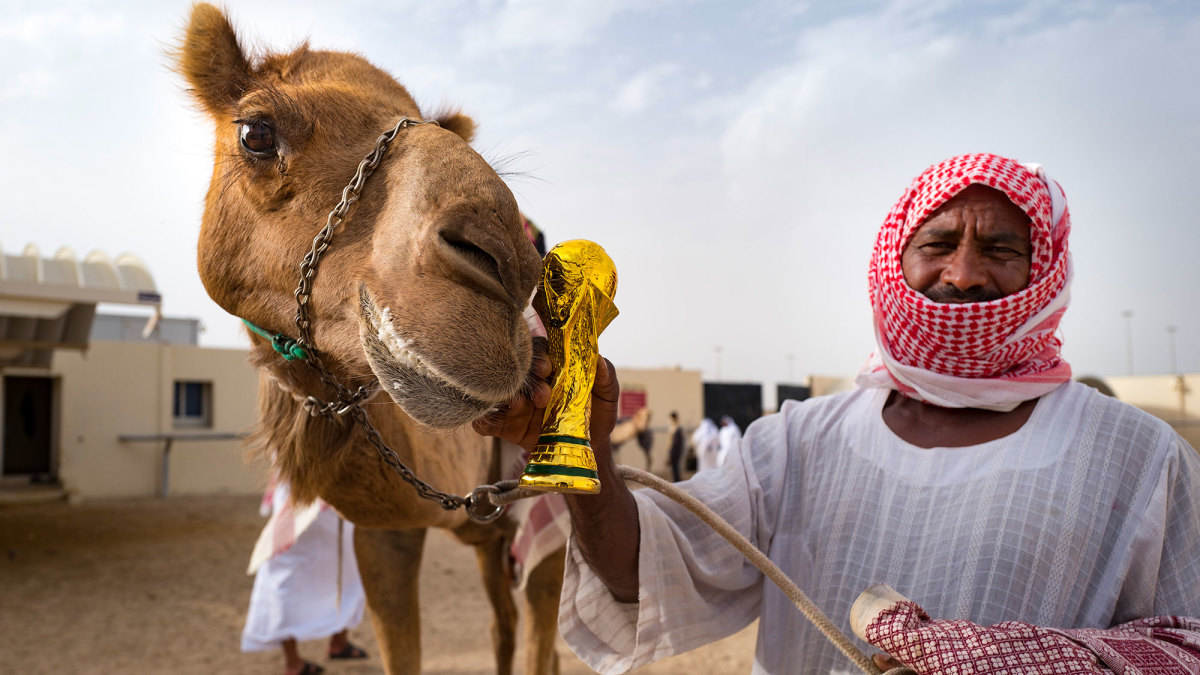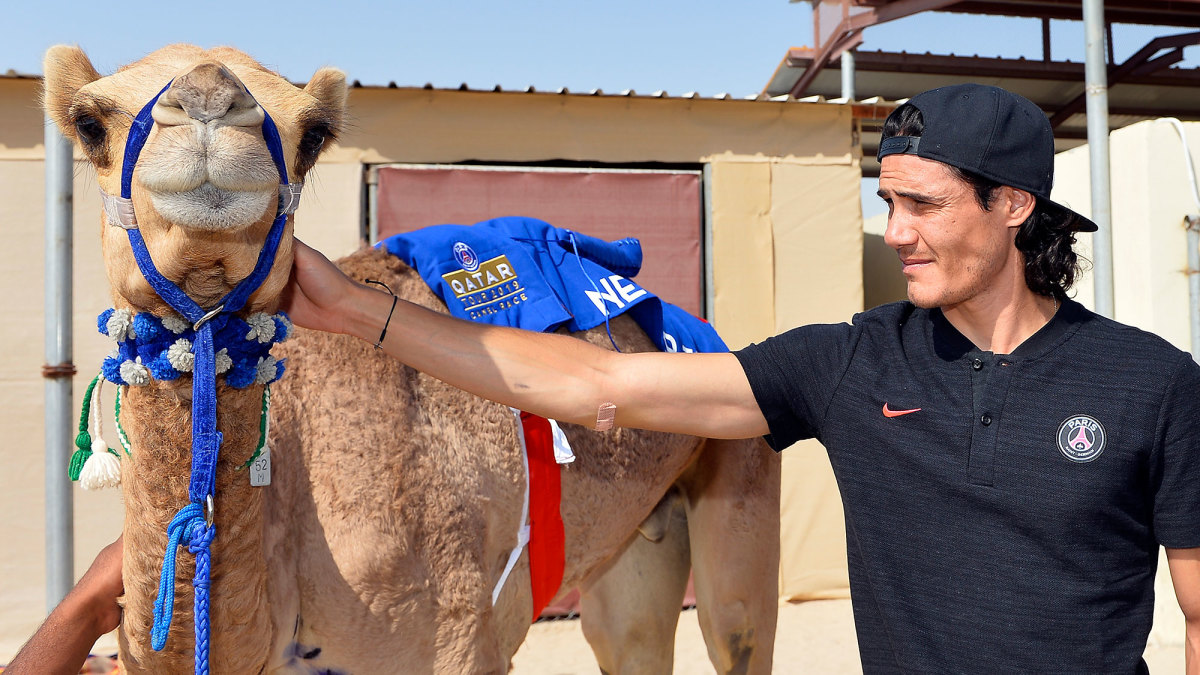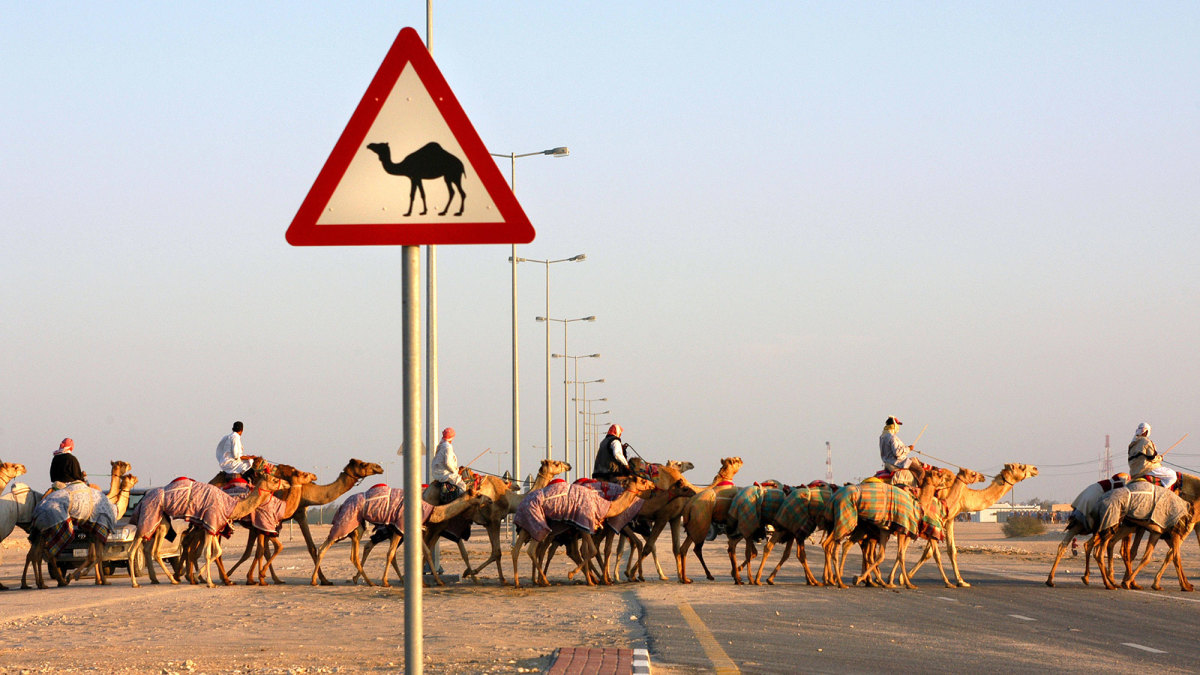The World Cup Is Here, but Qatar Has an Older Pastime: Camel Racing
ASH-SHAHANIYAH, QATAR – Just off the Dukhan Highway, roughly 24 miles from downtown Doha, there are two signs. One says, simply, Camel Village. And it is, well, exactly what it says, home to more than 20,000 camels and those who care for them.
The compounds stretch for miles along the desert, block after block of animal lodgings fashioned from brick and sand. There’s an under passage to access the other side of the highway, tall fences to keep the camels from wandering into traffic and dozens of plots of land run by competing groups. Each acts like the owner of a sports team; they’re training and competing in a surreal sport that started centuries ago and takes place all over the world.
The other sign doesn’t say anything at all. It’s white and circular, with red trim and a black image of a camel with a red line running diagonally through the hump. In other words, it’s a no-camel-crossing, which is funny and yet necessary for the health of drivers and jockeys alike.
The sun drops toward the horizon on Friday at Shahaniyah Camel Race Track LIMITED. There’s a crosswalk out front where camels hump across the street in front of cars. There are several tracks of varying lengths inside, all made from a mixture of dirt, pebbles and sand. On this night, the camels trot slowly, all around, as part of a training exercise. It resembles an NFL walk-through. (An official says the actual races this night have been canceled. He doesn’t say why, only to come back the next morning.)
On Sunday, the World Cup will begin roughly 37 miles to the northeast, at Al Bayt Stadium in Al Khor. But don’t mistake the world’s biggest sporting event for one of Qatar’s biggest and oldest sports. No, that would be camel racing, an endeavor that dates back to Medieval times. It started on the Arabian Peninsula in the seventh century, where elites staged races to entertain guests at weddings, festivals and other social gatherings. Like many aspects of life here, it marked an elevated social status, a vibe of we-do-it-because-we-can.

Late Friday, hundreds of camels, ridden by jockeys directing packs of two to five, traverse the grounds. They wear feed bags, elaborate-and-colorful blankets and blank expressions. SUVs drive slowly along the fence nearest the track, as a police car, sirens flashing, patrols nearby. A 15-feet-tall television plays a news broadcast at high volume near one starting gate, as reporters do live hits from various World Cup venues. There’s there – and there’s here. Two different worlds in roughly the same place.
This might seem like a cute exercise steeped in cultural norms and ancient history. It’s not. Like everything else in this country, it’s clouded by oppressive human rights violations, some of which were banned years ago. This is Qatar, so it’s possible to enjoy in the moment and feel uneasy about what led to it. One notion always outweighs the other.
Those who compete in camel racing would disagree. They describe the sport as international in popularity but with an even-deeper appeal here. It’s part of their culture, an infatuation; a means to achieve honor, compete in the gulf’s top sport, make money and impress the royal family in an enterprise that interests them.
Adjacent to the tracks, there’s a bank with a drive-thru ATM, a series of small and broken-down trailers for workers and a dilapidated shopping center with a restaurant, a coffee shop and a supermarket. There’s also a store that sells supplies a camel might need to race, along with supplements, medical equipment and much more.
Inside that store, four men sit around a desk, sipping the ever-present and ever-popular karak tea. They’re all “football” fans, sure. But more than that, they’re camel racing enthusiasts and practitioners who help keep this track running during the season, which stretches from October to March or April, depending on the year. They’re quick to point out that Neymar and his Paris Saint-Germain teammates visited this track in 2019 for an event that government officials held to honor him. The Qatar Sports Investments group owns the soccer club and, according to the men in the store, also funds much of the country’s camel racing.

They’re trying to explain the sport, how it has changed and what it means here and throughout the Gulf. They start with the basics, which doubles as a game of sorts.
Call it, Fun Facts About Camels You Never Knew You Needed.
For starters, there are two types: those with one hump (Dromedary) and those with two (Bactrian). All the racing camels here are Dromedary; the name derived from the Greek verb “dramein,” meaning to run. They grow up to six-and-a-half feet tall—height is typically measured from shoulder to ground—and weigh up to 1,350 pounds. And they were born for the desert life: three sets of eyelids and two strips of eyelashes combat any flying sand, while thick chests and thicker skin along the knees fight temperatures that rise up to 120 degrees in the summer. Their wide bearings and fibrous tissues allow for long walks marked by silence broken only by the occasional angry spit. They down more water than Tom Brady and fast, consuming more some 30 gallons in 15 hydrating minutes.
The conversation winds to weird, right then. Did you know that camel milk is used to make soap, ice cream and coffee creamer? That is has more vitamins than cow milk? That it’s lower in lactose and tastes sweeter? That it’s given to children to treat specific kinds of diarrhea? That its urine is sometimes used to, um, wash a human’s hair? That its dung can fuel or cure diaper rashes? That its hair is used to fashion scarves, blankets and ropes? That many believe dried camel brain cures epilepsy, and that camel marrow cures diphtheria, and that humps cure dysentery, or hides make sturdy rugs, or sinew helps glue bind together pieces of wood?
The camels who race, the men say, are typically separated from their mothers between the ages of 6 months and 1 year. They start racing around age 2, after apprenticing under retired competitors and beefing up through a diet of different types of grass, dates, honey and grains. Prospects are groomed for tracks of longer lengths as they get older – 2.5-3 miles for ages 2 to 4, 4.3-4.9 miles for ages 5 and 6 and 10Ks for the veterans before retirement, which typically happens around age 10.
The camels here, the men note, can reach speeds up to roughly 40 miles an hour for the races. They can maintain 25 miles an hour for around 60 minutes. Like other elite athletes, they train year-round, exercising in the evening. They walk, trot and jog on tracks with white railings, the surface smooth beyond the pebbles. They’re generally quiet and calm but known as some of the most stubborn animals alive. The men laugh as they lay out how sometimes, on a random day, a pig-headed participant will simply refuse to race.
Barbed-wire fences guard portions of the track near the starting gate. Races here run on a loose schedule, the men say; it can be haphazard, fluid. Typically, 10-15 events take place on Fridays and Saturdays, in the mornings and afternoons, with more added to each day deeper into each season, which culminates in the Emir Cup.
The “crowds” who watch aren’t like any in the U.S. Many venues, like this one, don’t have grandstands. Instead, there are carparks nearby fitted with building-sized projection screens that show races. But anyone driving or riding in an SUV can actually drive alongside the action, ladening meaning onto the phrase “spectator sport.”

There’s no betting on races in Qatar, at least not in the formal, sportsbook sense. The men say each individual winner receives a new SUV, a cash prize and, in the biggest events, ceremonial weapons like (seriously!) knives, swords and spears. They say that prize money has ballooned in recent years, with top purses at or nearing 5 million Qatari riyals (about $1.4 million), although it’s difficult to verify that sum from other accounts online. For the Emir Cup’s grand finale, the victor receives the most coveted prize of all – the Golden Sword. Sometimes, the Emir also buys the top female camels for breeding, marking another point of gratification. (According to CNN, one “bull camel” sold in the United Arab Emirates in 2017 for $9.5 million.)
Why do camels mean this much? The men explain that, too: popularity (in Western Asia, the Horn of Africa, North Africa, Australia, Mongolia and Pakistan and throughout the Gulf); necessity (the so-called Ships of the Desert have long transported goods, via a slow-but-swinging gait, because they can carry up to 1,000 pounds over long stretches); food (the men say camel meat is sweeter than beef and lower in fat, and nod yes while laughing when asked if such thing as a “camel burger” exists); and status (as prized possessions signifying vast wealth). Arabs loved camels so much they wrote poems about them and kept them outside their homes, as, well, pets.
As the importance of sports evolved over the past four decades or so, the men say, camel racing helped connect ancient history to modern times. Yes, there are big-money sponsorships in soccer, cricket, handball, golf, rugby and much more. And there are major events, like the world track and field championships Doha held in 2019. But camel remains local, cultural, theirs. The men insist that there are even beauty pageants for camels, and they believe, while camel racing is more of a sport for the rich, anyone can drive-watch, or projection-screen view, which can unify a country in perpetual contrast, however broad or minimally.
The sport’s darker side lies in human rights violations, although the men—and many officials in various public statements—believe it’s better now, if not entirely absent. Before this practice was banned, owners recruited small children as jockeys, kids sometimes as young as 2. Many suffered injuries from falls, or, worse yet, unthinkable exploitation, from kidnappings to physical injury to sexual abuse in camps not unlike those where migrant workers endured hellish conditions to build lavish World Cup stadiums. Not a few, either. More like 40,000, according to various reports from aid workers in countries where camel racing takes place.
Now, most tracks use robotic jockeys, complete with whips, except for training, although children were riding camels at this venue on Friday night. Perhaps this was simply to practice, but there is a nationwide ban on underage labor in Qatar. The robotic jockeys are controlled by humans who ride in cars alongside the action. This country banned child jockeys in 2005.
The men cite other issues: performance-enhancing drugs injected into camels; others deprived of food, water, or basic decency at compounds; frequent, avoidable deaths. “People here are crazy about this,” says Asaf Ahmed of India. “But sometimes, they just drop.” He pantomimes a camel falling dead on the track with both hands.
The men hope the World Cup brings progress, on two fronts: sports and education. They hope visiting fans stop by for the races, QAR in hand.
Late Friday evening, the sun at the track glows a bright orange. Camel caravans move from the track to the street and back to the track. A man standing near one starting gate points at a bucket of saffron and sprinkles some over a visitor’s head. “For blessings,” he says. Asked for his name, he lets loose a string of no-no-no’s and bolts.
There’s a photographer from Uruguay nearby, snapping pictures near a gate. Asked if he has ever seen anything like this before, he shakes his head. “No. Never. Only at the zoo,” he says with a small laugh.
The smell is exactly as expected, putrid and strong. Palm trees sway in the distance. The sound of car horns honking—at crossing camels—echoes into the night.
Training, it seems, is almost over. Tomorrow morning there will be races, and that means there will be beauty within chaos, alongside a checkered history, within a setting unlike any in sports. More than 1 million people are expected to visit Qatar in the coming weeks for one of the largest sporting events in the world. If they want to see where ancient customs meet a rapidly modernizing part of the world, they should stop by the races—in a car.
